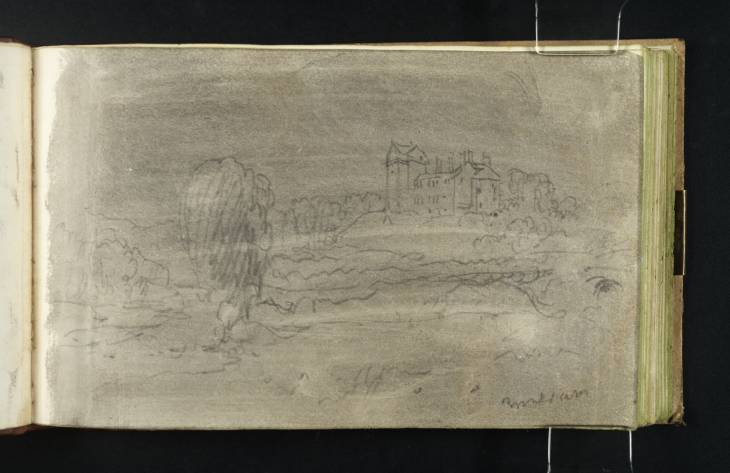Turner passed Branxholme Castle on 3 August 1831 on his route between Langholm and Hawick. The date is established in Robert Cadell’s diary entry for 4 August, in which he records that Turner was at Langholm on 2 August and that he spent the night of the 3rd at Hawick, before visiting Hermitage Castle on the 4th and arriving at Abbotsford that evening.
1 Following this, and another sketch of Branxholme (folio 86,
D25915), Turner took several sketches of Goldielands Tower (folios 88 verso and 89;
D25920,
D25921), which stands about a mile further up the River Teviot towards Hawick. The sketches are out out of sequence in the sketchbook, Turner having turned to the back of the book in order to use some of his pre-prepared grey washed pages. They should appear between folios 63 and 63 verso (
D25885–D258866). Perhaps because they were of sequence Turner inscribed the locations on two of the sketches (present page, and folio 89).
Neither Branxholme nor Goldielands appear in any of the proposed list of subjects to illustrate Sir Walter Scott’s Poetical Works. However, Branxholme, or Branksome Tower (as Scott spells it), features in the first line of the first canto of the Lay of the Last Minstrel, so if Turner had read it he may well have been on the look-out for the castle as he made his way up the Teviot.
Turner’s inscription, ‘Branksom’, is closer to Scott’s spelling than the traditional version, but this is not necessarily an indication that he had read the Lay of the Last Minstrel as his spelling was habitually phonetic.
The view on the present page, drawn with the sketchbook inverted, is from across the Teviot, so Turner must have crossed the bridge that is visible at the right of the sketch, as the road runs alongside the river on the same side as the tower. Turner must have disembarked here as there are close-up details of Branxholme on folio 86, and the views of Goldielands on subsequent pages show an approach along the river from the south. It is likely that Turner walked the rest of the way to Hawick as it was only three miles.
There are sketches of Branxholme Castle on folio 86, both from across the water a little to the south, as well as details of carvings and an inscription at the north gate to the castle.
Thomas Ardill
September 2009

